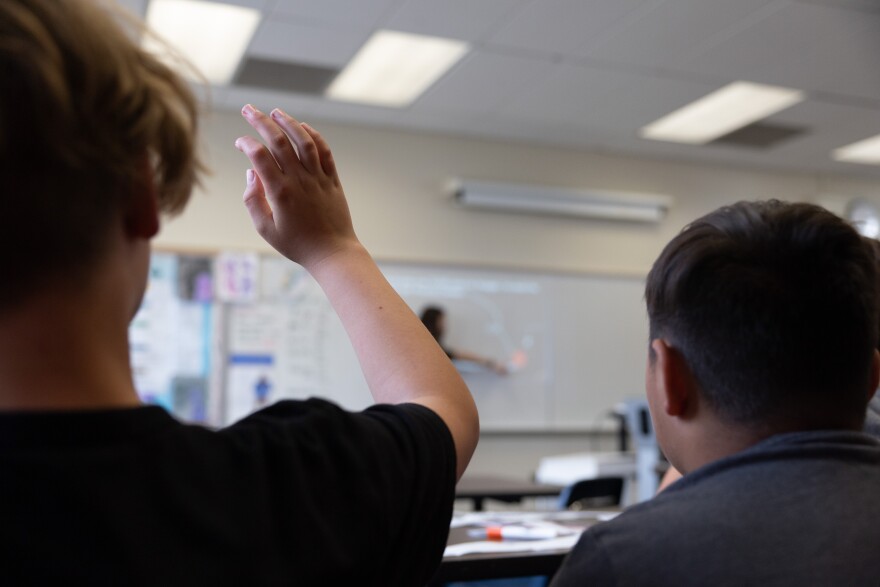California’s revenue is declining, but Los Angeles Unified leaders are cautiously optimistic about the district’s immediate financial outlook.
“We're holding firm on the commitment that we did not lay off any employee this year,” said Los Angeles Unified Superintendent Alberto Carvalho. “We will not lay off any employee next year, there will be no furloughs — we are adamant about protecting our essential programs for kids.”
LAUSD staff outlined a plan to restore previously restricted funding to individual schools in a board of education committee meeting Tuesday. The meeting followed the governor’s latest budget proposal the Friday before, which largely preserves education funding by drawing down reserves.
However, the district still faces the ongoing problem of spending more money than it’s bringing in. California school funding is tied to enrollment and fewer students are attending LAUSD — and the majority of districts in the state — every year.
This summer also marks the end of federal pandemic relief aid. LAUSD received more than $4 billion and used part of the money to hire hundreds of psychologists, psychiatric social workers, interventionists and other educators.
“What we're doing now is quickly doing something to make things better, and I'm supportive of that completely,” said board President Jackie Goldberg. “But it's not the solution. It doesn't tell us where we need to go.”
Restoring funding to schools
Earlier budget presentations proposed withholding the majority of the money each site had left at the end of each year. In prior years, schools retained 60% to 80% of their carryover funding to use the following year.
Thousands of educators and support staff rallied outside the board of education meeting last week to protest expected cuts to individual schools.
The union that represents campus aides, classroom assistants, and other support staff say their members’ hours for next year were reduced to balance the budget. In some cases, the loss of hours made workers ineligible for health benefits negotiated after last year’s strike.
“The district is centrally cutting off resources to individual schools and trying to blame individual schools for these cuts,” said Service Employees International United Local 99 Executive Director Max Arias. “We think that's too sneaky.”
Now, LAUSD plans to restore 50% of the carryover funding to the majority of schools.
Several hundred schools with large numbers of high-needs students and low academic outcomes will retain more money:
- 100 “priority schools” will keep 70% of carryover funding
- Schools with “highest” and “high” scores on the Student Equity Needs Index — which takes into account test scores, attendance, students’ socioeconomic status and the rate of COVID-19 illness and death — retain 60% of carryover funding.
Carvalho said the remaining money will be held in a reserve for schools until there are clearer financial projections from the state. The restored funding should eliminate cuts to employee hours next school year, he added.
District finance staff pointed to several factors that improved the district’s finances.
- More state funding. California plans to increase the annual cost of living adjustment to 1.07%, up from .76% proposed in January. The seemingly incremental change is worth $18 million.
- Increased attendance. The district forecasts the average daily attendance will increase to 92%, up from 90%, netting $48 million.
- Administrative cost-cutting. An estimated savings of $70 million from eliminating vacant non-school site positions and more efficient procurement. As of Tuesday, there was no estimate on which positions would be affected or what the repercussions of those vacancies might mean.
Some educators say that while they welcome the promise of more funding, the uncertainty over the budget has already affected employees.
At Thomas Starr King Middle School in Silver Lake, eighth grade science teacher and union chapter chair Cheryl Zarate said counselors and other support staff started looking for new jobs after finding out their hours could be cut.
“It might be too late,” Zarate said. “We might lose these counselors that have built relationships for years with our students.”
What about the $6 billion reserve?
The district currently projects a $6.3 billion “ending balance,” sometimes called a reserve. Why isn’t that money tapped to backfill the budget?
The short answer: It is — and the rest has already been spoken for.
Here’s an update from a story I wrote last year breaking down the different categories of funding from least to most flexible.
$48 million “non spendable”
Money that goes toward multi-year expenses. For example, the licenses for various apps on the district’s classroom management software Schoology.
$245 million “reserve for economic uncertainty”
California school districts are required to set aside a certain amount of money in case of a financial crisis. The average school district in the state has enough money to cover two months of spending, according to the Legislative Analyst’s Office. That money is determined by average daily attendance.
$1.83 billion “restricted”
Federal and state grants that are only available for a specific amount of time, for a specific purpose. For example, Proposition 28 money for arts education.
$2.903 billion “committed”
Funding for various initiatives and programs, including high needs schools, literacy programs and health benefits for retirees. This category includes the money for high-needs schools is known as the Student Equity Needs Index, or SENI. While advocates spent years pressing for SENI, even board members who have historically supported the fund say it's not off-limits to change.
The district’s seven-member board could vote to reallocate committed funds.
$442 million “assigned”
Unspent funding designated for specific schools. Technically, this money could be redirected by the district, but schools are already counting on it to pay for mental health support, classified and other positions.
$804 million unassigned
This is more accurately what you could call the district’s reserve. This money is being spent to offset the ongoing loss of funding.
“Those reserves, even just with current spending levels, will already be used,” said Senior Executive Director of Finance Policy Saman Bravo-Karimi on Tuesday. “If spending goes higher even than what's currently projected, then the impact will be that those reserves will be spent down sooner, faster.“
The current projections show LAUSD depleting its unassigned ending balance by the end of the 2025-26 school year.
What’s next
At the state level, lawmakers have until June 15 to approve a budget.
-
Budget Resource Guide: A summary of the LAUSD budget process, answers to frequently asked questions and an overview of California’s school funding policy.
-
May 14 LAUSD Board committee of the whole: This meeting included a presentation of the May Revision’s implications for public education and the district.
-
April 29 LAUSD Board retreat: A recording and materials from district staff’s comprehensive budget update. Some of the specific numbers mentioned are now outdated, but the overall discussion is helpful to understanding the financial planning process.
Meanwhile, LAUSD is updating school administrators about the restored carryover funding and the expectation is that educators and families will have an opportunity to weigh in on how the money is spent.
“We are trying to balance expediting this process while also having meaningful engagement with the necessary stakeholders,” Bravo-Karimi said.
LAUSD will hold a public hearing on its proposed budget June 18 and the board will vote on the final spending plan on June 25.
Speak up about the budget
-
LAUSD board members can amplify concerns from parents, students, and educators. Find your representative below.
-
District 1 map, includes Mid City, parts of South LA
Board Member George McKenna
Email: george.mckenna@lausd.net
Call: 213-241-6382 -
District 2 map, includes Downtown, East LA
Board Member Rocío Rivas
Email: rocio.rivas@lausd.net
Call: 213-241-6020 -
District 3 map, includes West San Fernando Valley, North Hollywood
Board Member Scott Schmerelson
Email: scott.schmerelson@lausd.net
Call: (213) 241-8333 -
District 4 map, includes West Hollywood, some beach cities
Board Member Nick Melvoin
Email: nick.melvoin@lausd.net
Call: 213-241-6387 -
District 5 map, includes parts of Northeast and Southwest LA
Board President Jackie Goldberg
Email: jackie.goldberg@lausd.net
Call: (213) 241-5555 -
District 6 map, includes East San Fernando Valley
Board Member Kelly Gonez
Email: kelly.gonez@lausd.net
Call: 213-241-6388 -
District 7 map, includes South LA, and parts of the South Bay
Board Member Tanya Ortiz Franklin
Email: tanya.franklin@lausd.net
Call: (213) 241-6385










